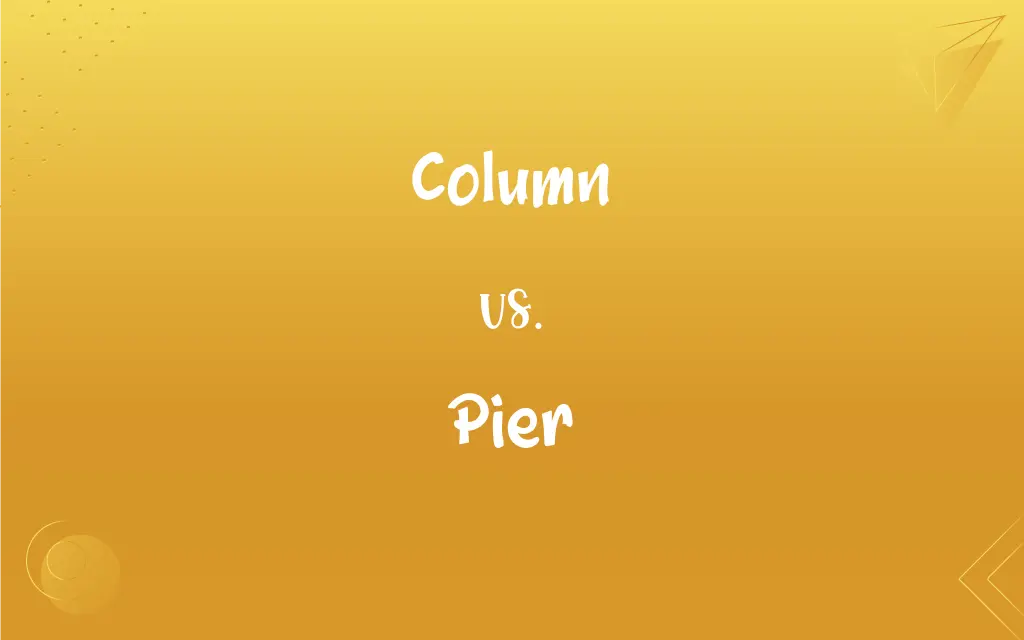Column vs. Pier: What's the Difference?
By Harlon Moss || Updated on May 22, 2024
A column is a vertical structural element that primarily supports weight, whereas a pier is a vertical support that transfers load from a bridge or other structure to the ground.

Key Differences
A column is a vertical structural element that supports weight, often used in buildings to bear loads from the roof or upper floors. It is essential in classical architecture and modern construction, providing stability and strength. A pier, on the other hand, is a vertical support structure commonly used to transfer loads from bridges or large structures directly to the ground or foundation. Piers are critical in civil engineering projects, such as bridge construction, where they support spans and distribute weight effectively.
Columns are typically seen above ground and contribute to the aesthetic and structural integrity of buildings. They are often exposed and visible as part of the architectural design. In contrast, piers are usually hidden or less visible since they are often located below ground or underwater, emphasizing their functional role over aesthetics.
Columns are designed to handle axial loads, meaning they bear weight from above along their length. They can also resist lateral forces to some extent, adding to the building's overall stability. Piers, however, are designed to handle both axial and lateral loads, particularly the lateral forces exerted by water or soil pressure.
Columns are integral to the design of buildings, often used in conjunction with beams to create a robust framework. In contrast, piers are integral to the design of infrastructure like bridges and large foundations, focusing on transferring loads to the ground safely and efficiently.
Comparison Chart
Function
Supports weight in buildings
Transfers load from bridges to the ground
ADVERTISEMENT
Visibility
Typically above ground
Often below ground or underwater
Material
Stone, concrete, steel
Reinforced concrete, steel
Load Handling
Primarily axial loads
Axial and lateral loads
Aesthetic Role
Often decorative as well as functional
Primarily functional, less decorative
Column and Pier Definitions
Column
A vertical support element in architecture.
The ancient Greek temples featured rows of marble columns.
ADVERTISEMENT
Pier
A solid structure for anchoring a bridge span.
Engineers inspected the pier for any signs of erosion.
Column
A structural component that bears load from above.
The building's roof rests on several sturdy columns.
Pier
A support for large buildings, transferring loads to foundations.
The skyscraper's foundation includes deep concrete piers.
Column
A decorative pillar.
The entrance is flanked by two ornate columns.
Pier
A support used in construction to distribute weight.
The new pier installations will ensure the stability of the deck.
Column
A vertical structure usually consisting of a base, a cylindrical shaft, and a capital, used as a support or standing alone as a monument.
Pier
A vertical support for bridges and docks.
The bridge's piers were reinforced to withstand the strong currents.
Column
Any slender vertical support, as of steel or reinforced concrete.
Pier
A structure extending into the water for docking boats.
We walked along the pier and watched the sunset.
Column
Something resembling an architectural column in form or function
A column of mercury in a thermometer.
Pier
A platform extending from a shore over water and supported by piles or pillars, used to secure, protect, and provide access to ships or boats.
Column
One of two or more vertical sections of text lying side by side in a document and separated by a rule or a blank space.
Pier
Such a structure used predominantly for entertainment.
Column
An arrangement of numbers in a single vertical line.
Pier
A supporting structure at the junction of connecting spans of a bridge.
Column
A feature article that appears regularly in a publication, such as a newspaper.
Pier
A pillar, generally rectangular in cross section, supporting an arch or roof.
Column
A formation, as of troops or vehicles, in which all elements follow one behind the other.
Pier
The portion of a wall between windows, doors, or other openings.
Column
(Botany)A columnlike structure, especially one formed by the union of a stamen and the style in an orchid flower, or one formed by the united staminal filaments in flowers such as those of the hibiscus or mallow.
Pier
A reinforcing structure that projects from a wall; a buttress.
Column
(Anatomy)Any of various tubular or pillarlike supporting structures in the body, each generally having a single tissue origin and function
The vertebral column.
Pier
A raised platform built from the shore out over water, supported on piles; used to secure, or provide access to shipping; a jetty.
Your boat is docked at the pier.
Column
(architecture) A solid upright structure designed usually to support a larger structure above it, such as a roof or horizontal beam, but sometimes for decoration.
Pier
A similar structure, especially at a seaside resort, used to provide entertainment.
There is a gaming arcade on the pier.
Column
A vertical line of entries in a table, usually read from top to bottom.
Pier
A structure supporting the junction between two spans of a bridge.
Column
A body of troops or army vehicles, usually strung out along a road.
Pier
(architecture) A rectangular pillar, or similar structure, that supports an arch, wall or roof, or the hinges of a gate.
Column
A body of text meant to be read line by line, especially in printed material that has multiple adjacent such on a single page.
It was too hard to read the text across the whole page, so I split it into two columns.
Pier
Any detached mass of masonry, whether insulated or supporting one side of an arch or lintel, as of a bridge; the piece of wall between two openings.
Column
A unit of width, especially of advertisements, in a periodical, equivalent to the width of a usual column of text.
Each column inch costs $300 a week; this ad is four columns by three inches, so will run $3600 a week.
Pier
A projecting wharf or landing place.
Column
(by extension) A recurring feature in a periodical, especially an opinion piece, especially by a single author or small rotating group of authors, or on a single theme.
His initial foray into print media was as the author of a weekly column in his elementary-school newspaper.
Pier
A platform built out from the shore into the water and supported by piles; provides access to ships and boats
Column
Something having similar vertical form or structure to the things mentioned above, such as a spinal column.
Pier
(architecture) a vertical supporting structure (as a portion of wall between two doors or windows)
Column
(botany) The gynostemium
Pier
A support for two adjacent bridge spans
Column
(chemistry) An object used to separate the different components of a liquid or to purify chemical compounds.
Column
A kind of pillar; a cylindrical or polygonal support for a roof, ceiling, statue, etc., somewhat ornamented, and usually composed of base, shaft, and capital. See Order.
Column
Anything resembling, in form or position, a column in architecture; an upright body or mass; a shaft or obelisk; as, a column of air, of water, of mercury, etc.; the Column Vendôme; the spinal column.
Column
A body of troops formed in ranks, one behind the other; - contradistinguished from line. Compare Ploy, and Deploy.
Column
A number of ships so arranged as to follow one another in single or double file or in squadrons; - in distinction from "line", where they are side by side.
Column
A perpendicular set of lines, not extending across the page, and separated from other matter by a rule or blank space; as, a column in a newspaper.
Column
A perpendicular line of figures.
Column
The body formed by the union of the stamens in the Mallow family, or of the stamens and pistil in the orchids.
Column
One of a series of articles written in a periodical, usually under the same title and at regular intervals; it may be written and signed by one or more authors, or may appear pseudonymously or anonymously, as an editorial column.
Column
A line of (usually military) units following one after another
Column
A vertical glass tube used in column chromatography; a mixture is poured in the top and washed through a stationary substance where components of the mixture are adsorbed selectively to form colored bands
Column
A linear array of numbers one above another
Column
Anything tall and thin approximating the shape of a column or tower;
The test tube held a column of white powder
A tower of dust rose above the horizon
A thin pillar of smoke betrayed their campsite
Column
An article giving opinions or perspectives
Column
A vertical structure standing alone and not supporting anything (as a monument or a column of air)
Column
(architeture) a tall cylindrical vertical upright and used to support a structure
Column
A vertical division of text in a page or spreadsheet.
The data was organized into columns for clarity.
Column
A formation of troops or vehicles moving in a single file.
The army advanced in a tight column through the valley.
FAQs
What materials are columns made from?
Columns can be made from stone, concrete, or steel.
Where are piers typically used?
Piers are commonly used in bridges, docks, and large foundations.
Do piers serve an aesthetic purpose?
Piers are primarily functional and less decorative, often hidden from view.
What is a pier?
A pier is a vertical support structure that transfers loads from bridges or other structures to the ground.
What is a column?
A column is a vertical structural element used to support weight in buildings.
Where are columns typically used?
Columns are typically used in buildings and architectural structures.
Can columns handle lateral loads?
Columns can resist lateral forces but are primarily designed for axial loads.
What materials are piers made from?
Piers are usually made from reinforced concrete or steel.
Do columns serve an aesthetic purpose?
Yes, columns can be both decorative and functional in architectural design.
Can piers handle lateral loads?
Yes, piers are designed to handle both axial and lateral loads.
Are piers visible in a structure?
Piers are usually hidden or located below ground or underwater.
What is an example of a functional pier?
e.g., The bridge's piers are crucial for distributing weight to the ground.
What architectural style frequently uses columns?
Classical architecture often features columns prominently.
What type of engineering project relies heavily on piers?
Bridge construction relies heavily on the use of piers for support.
How do piers contribute to stability in bridges?
Piers transfer loads to the ground, ensuring the stability of the bridge span.
Can columns be part of modern buildings?
Yes, columns are used in both classical and modern architectural designs.
Can piers be part of modern infrastructure?
Yes, piers are essential in modern infrastructure projects like bridges and large buildings.
Are columns visible in a building's structure?
Yes, columns are often exposed and visible as part of the design.
What is an example of a decorative column?
e.g., The marble columns in the museum's entrance are purely decorative.
How do columns contribute to building stability?
Columns support vertical loads and add to the overall structural integrity.
About Author
Written by
Harlon MossHarlon is a seasoned quality moderator and accomplished content writer for Difference Wiki. An alumnus of the prestigious University of California, he earned his degree in Computer Science. Leveraging his academic background, Harlon brings a meticulous and informed perspective to his work, ensuring content accuracy and excellence.































































